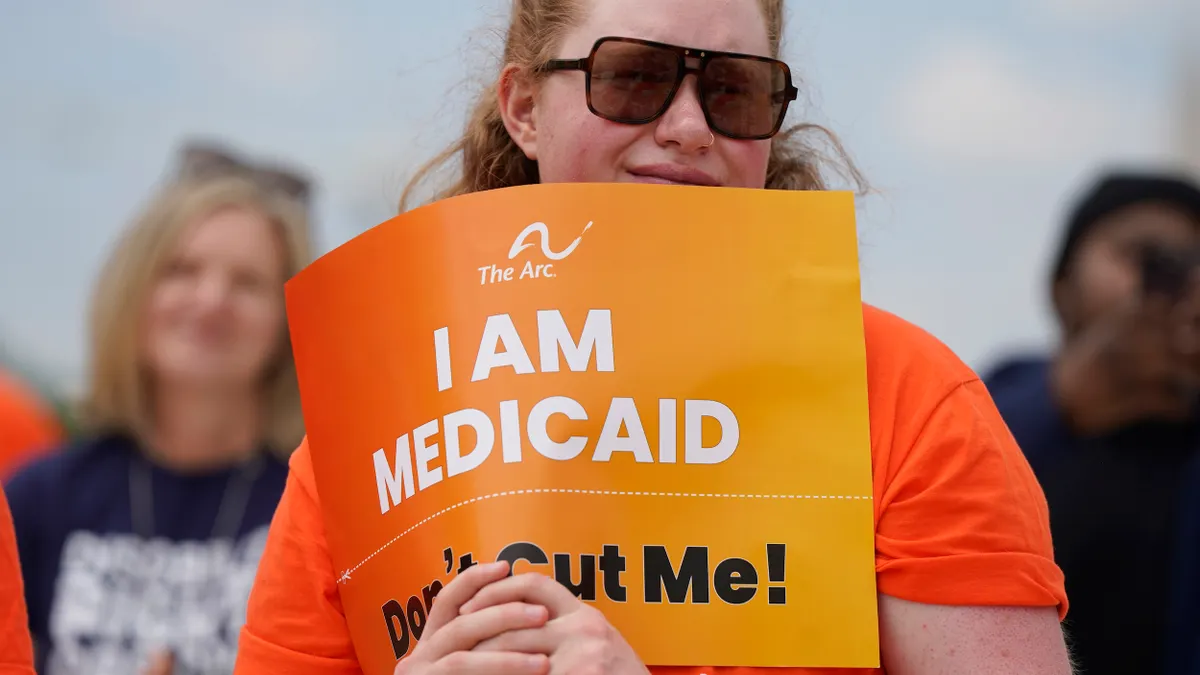Dive Brief:
- Medicaid cuts could have “far-reaching” consequences for the healthcare sector and the broader economy, driving up preventable hospitalizations and excess deaths while cutting revenue for providers, according to research published Wednesday in JAMA Health Forum.
- Coverage losses due to the massive tax and policy law recently signed by President Donald Trump are estimated to cause more than 1,400 excess deaths and over 94,000 preventable hospitalizations annually by 2034, the study found.
- The cuts will also result in federally qualified health centers losing 5 million Medicaid enrollees each year, while gaining 1.9 million uninsured patients — causing a $3.3 billion reduction in revenue.
Dive Insight:
The “One Big Beautiful Bill” signed into law early this month includes a number of healthcare provisions, but some of the most controversial are $1 trillion in federal spending cuts to Medicaid.
The law implements historic changes to the safety-net insurance program, including mandating some beneficiaries log work, volunteer or education hours to maintain coverage and requiring states to check enrollees’ eligibility more frequently.
Nearly 12 million additional people are expected to become uninsured by 2034 because of the law, according to an analysis by the Congressional Budget Office.
The latest research published in JAMA Health Forum found the law could have serious consequences across healthcare and the economy — including negative health outcomes, disruption to providers and job losses.
By 2034, coverage losses could result in 1.6 million people delaying care due to cost each year, as well as 1.9 million cases of medication nonadherence annually, according to the study.
The cuts will also have a significant impact on providers, especially those caring for underserved and rural communities who may rely more heavily on Medicaid reimbursement. By 2034, more than 100 rural hospitals are estimated to be at high risk of closure.
Additionally, providers will have to help patients manage more frequent eligibility checks and work requirements, Dr. Sanjay Basu, as associate professor at the University of California San Francisco and an author of the study, told Healthcare Dive.
“For my colleagues in primary care, there is a large worry about the sheer burden of added paperwork that’s likely to come down the pipe,” Basu said.
Funding reductions to the safety-net insurance program could have other economic effects as well. By 2034, losses in insurance coverage could produce $7.6 billion in medical debt. The analysis also found 302,000 jobs could be lost and economic output could be reduced by $135.3 billion.
Job losses linked to Medicaid cuts could impact healthcare workers, as providers lay off employees or cut services to recoup lower reimbursements and increases in uncompensated care.
But eventually others could lose work, including former beneficiaries who became sicker because they couldn’t access care and became disabled, Basu said.
The loss of health coverage also impacts consumer spending, affecting the broader economy.
“If people have better health insurance coverage, they tend to be able to spend on other things,” Basu said. “So you might be able to spend on your rent or food or other expenditures, and not be saving as much for your medication copays or other health-related expenditures.”
The study may underestimate the impact from the Medicaid cuts, he added. It uses an earlier CBO report that estimated 7.6 million people would become uninsured by 2034 due to the changes to Medicaid. However, later versions of the legislation included deeper cuts to the safety-net insurance program.
There could be variation in how states implement the Medicaid changes. But if more people lose Medicaid coverage, the healthcare and economic impacts could be more severe, according to the research. The study included a scenario where 14.4 million people lose the safety-net insurance by 2034, which would increase excess deaths above 2,200 and preventable hospitalizations beyond 145,000 annually.
In that scenario, 408,000 jobs could be lost and economic output could decline by $182.6 billion.















